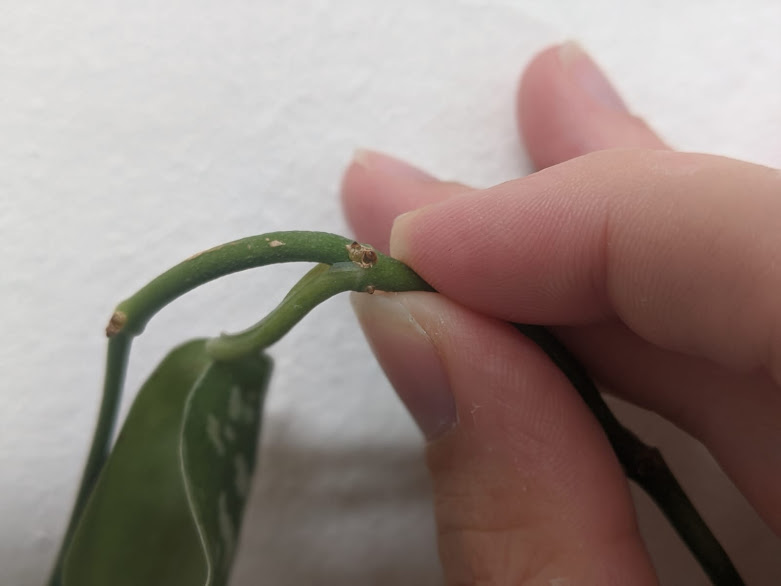*me posing like a proud plant-mum*
Hi!
Sooo, plant propagation is today's topic. Before I start, I often get the comment of friends that I have (too) many plant/plant cuttings. In my world, there can never be too many plants, but I share this because I hope that this will increase your belief in my credibility for this topic. Even though I am still young, I am a plant mum of many plants that all (but one) thrive in my care. Yes, my aloë is the rebel of them all and does not want to live anymore (so it seems). But that aside, plant propagation. For those with no clue what it means: creating a new plant from an already existing one. Aka: PLANT BABIES :D
I will start with the basics. Many plants with stems have certain areas where new roots grow from, these are called nodes. A node is a spot where a leaf attaches to the stem and 'a small growth zone'. A good example is this Scindapsus Pictus, also known as the silver or satin pothos, that I have, as you can see, there are some brownish dots on the stem. What you see on the picture is a node, the brown spot are points where new roots can grow from. When making a cutting, always make sure that you have a node, this node needs to be set in water to grow roots.
This is mama-plant.
Here you see the new roots the plant has grown in water, I am not 100% sure, but I believe that this has been standing in a glass of water for about three to four weeks now. The roots are as on as my little finger. Eventually, I will transfer this cutting to earth.
The next example I have for you is another type of pothos, this plant is perfect for people that kill plants easily because it grows so fast, even when neglected. This plant has vine-like stems and climbs or hangs. From this plant, I have already taken 5 or more cuttings and I think I have it for about 3 months now. It grows incredibly fast and I am in love with it.
This plant also has clear nodes but also grows air-roots (like a monstera deliciosa). This is one of many cuttings and has already grown large water roots. Because I will give this one to my mum I will not put it into earth, but it is ready for it. It is important when transferring a cutting from water to earth is that you keep is wet in the first few weeks. The roots of the cutting have to adjust to the earth and your cutting will die if it is too dry. So, in the first 3 to 4 weeks keep the earth very wet and slowly make it less and less wet after those weeks. Like I said earlier, this plant is very hard to kill and it grows very fast, it is perfect to take cuttings from!
A plant you have probably seen before: the pancake plant (aka pilea peperomioides). This plant is very popular nowadays and is a fun plant to have. Besides the fact that it is a fun and pretty plant, this plant creates its own babies!
As you see here, this baby has grown roots in water. Pancake plants can survive solely on water, you do not have to transfer them to earth if you do not want to. If you do, here too, make sure that the roots can adjust to earth by keeping it wet. Pancake plants keep producing babies so it is important to give them their own pot when they become too big. I think that these are fun gifts for friends and family, to lure them into the plant life.
Another way to creating more plants is by breaking it. This is a silver squill, this plant does not create baby plants like a pancake plant and it is not a possibility to take a cutting form it. So to make more of them, you will need to break it apart. Another plant you can use this technique for is the snake plant. This silver squill is not that big but too big for this pot, however, I want to keep it in the pot. So I will break this plant apart so you can see what I mean.
I have taken the plant out of the pot and loosened the earth out of the roots. Next, I will find a spot where I can easily tear the plant into two parts without destroying much of its roots. Make sure that the newer plants also has roots, otherwise it will not grow.
As you can see on this picture, the plant has now become two plants, both with a lot of roots left. These can just be put back into a pot. I always shake loose roots and earth off of them, before setting them back. Some roots will be destroyed in the process and that is totally fine as long as both plants keep roots. This is the second time I have broken this plant, it needs some time to adjust. Because you've just literally torn it in two, but after that time it continues to grow and it will do just fine! When you think that it is too big again you can repeat this cycle.
That was it for this post, I hope you have enjoyed it and many learned a thing or two. In the near future, I will do a thorough update on all my plants and show you some new ones that I've bought recently. I hope that you have a good day and I will see you soon!
Love,
Julia

















Post a Comment